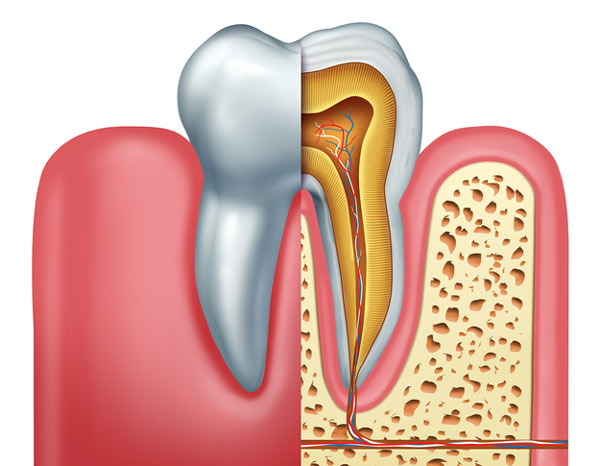
San Francisco Root Canal Treatment Approximately 15 million teeth undergo a root canal treatment each year. Approximately 15 million teeth undergo a root canal treatment each year. So, rest easy because you are not alone. The words "root canal" strike fear in many patients suffering from tooth pain. However, you will be happy to know that most people who have received this treatment say it's similar to a dental filling. If you are experiencing severe tooth pain and are having difficulty chewing, your tooth might be infected. Visit our San Francisco dentist to get a thorough dental checkup, receive a second opinion, and uncover the cause of the problem. For more information or to schedule an appointment, call 415-981-9000 today! Signs You Need a Root CanalA root canal treatment allows the dentist to remove infection from your tooth, without much pain. Here are a few symptoms to help you identify if the procedure may be required. Tooth Pain That Won't Go AwayPlenty of things cause tooth pain. However, deep pain that reaches the jaw and surrounding teeth indicates an infection. It Hurts When You Put Pressure on Your TeethDoes it hurt after you eat something crunchy? This indicates not only sensitivity but also damaged nerves affecting your tooth pulp. Swollen GumsInfected teeth often swell up the gums and make them tender to the touch. Pimples on the GumsInfected teeth develop boils or pimples on the gums that ooze pus, which might cause halitosis (bad breath). Swollen JawIf pus isn't drained, the infection becomes severe and can cause your jaw to swell. Discolored ToothThe swelling caused by infection stops blood from reaching the teeth. This discolors your tooth, giving it a dark appearance. Loose ToothIf the pus starts to leak, it impacts the dentin underneath your tooth enamel. The bacteria softens them, loosening the tooth. Step-by-Step Root Canal ProcedureA San Francisco root canal procedure is completed in four steps. These are explained in detail below: Step #1 – Cleaning the Root CanalThe dentist first reviews the patient's dental history. This allows them to determine which medicine the patient is allergic to. The procedure starts with our dentist giving the patient local anesthesia. Next up is an X-ray of the tooth. This reveals how much the infection has spread. To ensure the surgery site remains clean, our dentist uses a dental dam. This is a protective sheet that is placed near the tooth. It helps isolate the infected area. As a result, any buildup of saliva does not reach the tooth. Step #2 – Shaping the Root CanalTo prepare for the root canal, our dentist makes a small cut in the crown. Using very small instruments, they clean the pulp and shape the space.  Step #3 – Filling the Root CanalAfter the space is cleaned, it is shaped and readied to receive the filling. This is usually a biocompatible material called gutta-percha. Made from a rubber-like substance, this is a permanent filling. The gutta-percha is fixed in place with cement, sealing the root canal. If there's swelling, our dentist uses a temporary filling, which is later removed at the time of restoration. Step #4 – Adding a CrownOnce the filling is in place, you will receive a dental crown. Depending on how severely the tooth is impacted, the dentist might recommend other restoration options for full function. If the tooth has no support structure, another step is added to the procedure. Your dentist will insert a post inside the tooth to keep it steady. For more information on the precise restoration of your tooth, speak with our team today! Root Canal Recovery – AftercareRoot canal treatments have a 95% success rate. They help restore teeth that last a lifetime. Many people can resume their daily routine within a few days. While the numbness wears off immediately, you might experience some sensitivity. This occurs due to inflammation and can be easily minimized with painkillers. Though rare, complications can occur. If the root wasn't cleaned properly, you must watch out for new infections. Undetected cracks in a tooth's root, minor openings in the sealing, and restoration problems cause bacteria to contaminate the site. In such cases, your dentist will recommend surgery, such as root-end resection. This will minimize inflammation, saving the tooth. With the permanent filling in place, your once fragile tooth will now be ready for chewing. A root canal becomes necessary after a tooth infection or decay. This happens when you don't maintain a regular oral hygiene routine. So, brush and floss regularly, and keep up with your yearly dental appointments. Minimizing Root Canal PainIt is common to experience pain after a root canal for a few days. Though the pain is less because the infection is removed, a slight discomfort may persist. Here are some tips to try for root canal pain relief:
If the pain continues, visit our dentist immediately. Risks of Root CanalsA root canal treatment can fail. This happens not because you didn't take proper post-procedure care but because the root canal wasn't the right fit. Our dentist will inspect your teeth and recommend cleaning the infection for another root canal. However, if the tooth cannot be saved and is completely damaged beyond repair, we may recommend a dental bridge or implant. Tips to Avoid a Root Canal Treatment
|
|
|